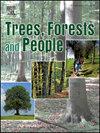Impacts of phosphite treatment on Phytophthora community assemblages and inoculum abundances in Phytophthora-infected forest soil
IF 2.7
Q1 FORESTRY
引用次数: 0
Abstract
Phytophthora are causing declines in forest tree species worldwide and the chemical control treatment, phosphite, is the only treatment consistently shown to provide some protection to natural ecosystems from Phytophthora diseases. Phosphite inhibits Phytophthora growth and sporulation whilst boosting defence responses in the plant host. It is unclear, however, the extent of the impact of phosphite on Phytophthora species assemblages and inoculum abundances in soil around trees following treatment within natural ecosystems. In New Zealand, kauri (Agathis australis), an endemic and threatened foundation species, suffers from a dieback disease primarily caused by Phytophthora agathidicida. Phosphite is applied by trunk injection to kauri and has been shown to improve resin ‘bleed’ symptoms from basal trunk lesions and to promote recovery of thinned canopies. Phytophthora community and inoculum abundance were investigated in response to phosphite treatments at two field sites (Huia and Waitoki) in infected kauri stands in Auckland, New Zealand. At Huia, soil sampling and tree health surveying were conducted in November 2023 on trees treated with phosphite in 2012 as part of an earlier study. At Waitoki, the response to phosphite treatment was monitored 6 and 18 months following treatment. Phytophthora species were detected using soil baiting and metabarcoding of Environmental DNA (eDNA) from soil and quantified with qPCR of root and soil DNA. Three species were detected with soil baiting (P. agathidicida, P. cinnamomi, and P. multivora) and two additional species with metabarcoding (P. pseudocryptogea, and an unknown clade 7 species similar to P. europaea). Phytophthora cinnamomi was the most abundant species, followed by P. agathidicida. Both species were more likely to occur together than by chance alone and were associated with declining tree health. The P. europaea-like species was in approximately 50 % of the samples and was less likely to occur in roots with poorer health, or in association with P. agathidicida. The abundance of P. agathidicida inoculum was lower in the soil around the phosphite-treated trees than around the untreated control trees 1.5 years after treatment at Waitoki. Phosphite halted the lateral expansion of basal resin bleeds, and resin viscosity was reduced. Not only did phosphite treatments improve kauri dieback symptoms, but the phosphite treatments potentially had a direct impact on the epidemiology of the disease by reducing inoculum load around treated trees, with direct implications for disease management as an effective way to protect uninfected areas and minimise the spread of inoculum from infested zones.
亚磷酸处理对受 Phytophthora 感染的森林土壤中 Phytophthora 群落组合和接种体丰度的影响
噬菌体病害导致全球森林树种减少,而化学防治处理方法亚磷酸是唯一被证明能在一定程度上保护自然生态系统免受噬菌体病害侵袭的方法。亚磷酸可以抑制噬菌体的生长和孢子繁殖,同时增强植物宿主的防御反应。不过,目前还不清楚在自然生态系统中,亚磷酸对树木周围土壤中的噬菌体物种群和接种体丰度的影响程度。在新西兰,鹅掌楸(Agathis australis)是一种特有且濒临灭绝的基础树种,主要由嗜磷菌(Phytophthora agathidicida)引起的枯萎病。亚磷酸盐通过树干注射的方式应用于金丝楠木,已被证明可以改善树干基部病变引起的树脂 "出血 "症状,并促进稀疏树冠的恢复。在新西兰奥克兰受感染的楠木林中的两个实地考察点(Huia 和 Waitoki),研究了噬菌体群落和接种体丰度对亚磷酸处理的反应。作为早期研究的一部分,2023 年 11 月在 Huia 对 2012 年用亚磷酸盐处理过的树木进行了土壤取样和树木健康调查。在怀托基,对亚磷酸处理后 6 个月和 18 个月的反应进行了监测。利用土壤诱饵和土壤中环境 DNA (eDNA) 的代谢条形码检测噬菌体物种,并利用根和土壤 DNA 的 qPCR 进行量化。土壤诱饵法检测到三个菌种(P. agathidicida、P. cinnamomi 和 P. multivora),元条码法检测到另外两个菌种(P. pseudocryptogea 和一个与 P. europaea 相似的未知支系 7)。Phytophthora cinnamomi 是数量最多的物种,其次是 P. agathidicida。这两个物种一起出现的几率比单独出现的几率要高,而且与树木健康状况下降有关。类似 P. europaea 的物种出现在大约 50% 的样本中,而且不太可能出现在健康状况较差的树根中,也不太可能与 P. agathidicida 一起出现。在 Waitoki,经过亚磷酸处理的树木周围土壤中的 P. agathidicida 接种体的数量在处理 1.5 年后低于未处理的对照树木周围土壤中的接种体数量。亚磷酸盐阻止了基部树脂渗出的横向扩展,并降低了树脂粘度。亚磷酸处理不仅改善了猕猴桃的枯死症状,而且通过减少处理过的树木周围的接种体负荷,亚磷酸处理还可能对该疾病的流行产生直接影响,这对疾病管理具有直接意义,因为它是保护未感染地区并最大限度地减少接种体从侵染区扩散的有效方法。
本文章由计算机程序翻译,如有差异,请以英文原文为准。
求助全文
约1分钟内获得全文
求助全文
来源期刊

Trees, Forests and People
Economics, Econometrics and Finance-Economics, Econometrics and Finance (miscellaneous)
CiteScore
4.30
自引率
7.40%
发文量
172
审稿时长
56 days
 求助内容:
求助内容: 应助结果提醒方式:
应助结果提醒方式:


